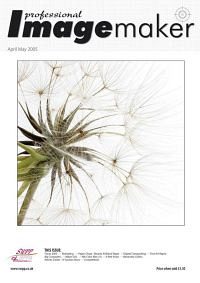articles/Cameras/kodakdcs-page2
KODAK DCSPro14n Big Chips for High Rollers - part 2 of 1 2 3 4 5
by Mike McNamee Published 01/04/2005

This composite image shows the coverage of the Kodak DCSPro 14n compared to the Nikon D100. The area is twice as large. Note that this image also shows the use of the incorrect Lens Calibration setting leading to the colour cast from magenta to green.
Body Design
The DCS 14n takes some parts of the Nikon 80, the auto focus of the F80 and the metering of the F5. These are attached to a new moulded metal body which is fatter than the F80. The base plate of the camera holds the battery pack which gives a very wide platform for tripod mounting and also holds the vertical-shooting release button. All the knobs and buttons are in the usual places and finding your way around is very simple.
It is the fat bottom which prevents about 15 Nikkors from fitting to the DCS 14n.

Setting up for accurate colour in the studio is extremely smple using Photo Desk. A couple of mouse clicks provided this accurate and pleasing colour quality.
Software
The files are best handled via the Kodak DCS PhotoDesk software. This provides a high level of flexibility with great accuracy and control of colours. Adobe RAW does not work at all well with Kodak RAW files and should be avoided. Within Photo Desk adjustments may be made for White Balance, Exposure and a host of other tweaks such as "Looks" profiles.
The Electronics
The Complementary Metal Oxide Silicon chip (CMOS) is full frame 13.9 MP with sensitivities from 80 ISO through to 400 ISO and then to 800 ISO at 6MP. The decision by Kodak to relinquish any micro lenses on the individual pixels assists with keeping colour fringing under control but reduces the effective ISO of the camera. In the studio this is no problem there is usually tons of light available. Some may find it a little limiting at a wedding on a dull November afternoon. The shutter speeds range from 30s to 1/4000ths and the flash synch speed is 1/125ths. The camera runs at 1.7fps with a burst depth of 4 (JPEG files) to 7 (RAW files). JPEG files slow things down because the camera has to perform more image processing. The camera is slow to start up, requiring about seven seconds but this has been improved from the original 15seconds with the latest firmware upgrade. The chip has a 8-micron pixel pitch and no micro lenses or anti aliasing filters are employed. At 35mm, full frame, the chip is twice the size the "4/3" standard of the Nikon D100 and Fuji S2 and the superimposed pair of shots illustrates this is image terms. The 4500 by 3000 pixel file is 12.6MB in RAW Format and 38.6MB as an RGB TIFF file. CMOS chips have a reputation of not being as sharp, pixel for pixel, as CCD devices and a certain amount of post exposure manipulation is required to control the noise and artifacting of the CMOS set-up. That said the file is twice the size and so there is more scope for enlargement.
Please Note:
There is more than one page for this Article.
You are currently on page 2
- KODAK DCSPro14n Big Chips for High
Rollers page 1
- KODAK DCSPro14n Big Chips for High
Rollers page 2
- KODAK DCSPro14n Big Chips for High
Rollers page 3
- KODAK DCSPro14n Big Chips for High
Rollers page 4
- KODAK DCSPro14n Big Chips for High
Rollers page 5
1st Published 01/04/2005
last update 09/12/2022 14:55:34
More Cameras Articles
There are 0 days to get ready for The Society of Photographers Convention and Trade Show at The Novotel London West, Hammersmith ...
which starts on Wednesday 15th January 2025





